June 12, 2009
Air Date: June 12, 2009
FULL SHOW
SEGMENTS
Countdown to Copenhagen
/ Bruce GellermanView the page for this story
Scientists say huge cuts are needed to avoid dangerous disruption of our climate. But delegates gathered in Bonn to craft the first phases of a new climate treaty made little progress, with major polluters, the U.S. and China, unable to reach agreement. But, as Living on Earth’s Bruce Gellerman tells host Steve Curwood, there does seem to be some good news for developing nations: direct aid, in the form of hundreds of billions of dollars and technology, is on the table to help poor nations adapt to climate disruption. (06:30)
Climate Change and America’s Poor
View the page for this story
Climate change will hit the poor and disadvantaged the hardest, not just in developing countries abroad but also here at home. A new study from the University of California, Berkeley has found that low-income communities and people of color in the United States will suffer the most from the health and economic consequences of rising global temperatures. Study co-author Rachel Morello-Frosch talks with host Jeff Young about how this climate gap works and how we can close it. (05:30)
Forest Salvation
/ Ingrid LobetView the page for this story
Trees can soak up carbon dioxide, one of the major greenhouse gases, from the air. Now, California has created one of the first regulated methods for landowners to make money by growing more trees, more quickly, and other states are following suit. Living on Earth’s Ingrid Lobet reports on how forests can help landowners provide part of the solution to climate change. (18:00)
Tiny Glider Swims Big
View the page for this story
A remote-controlled underwater robot is probing the ocean for clues about the impact of climate change. The six foot glider called RU27 was launched by students and scientists from Rutgers University in New Jersey. If all goes well, RU27 is expected to stay at sea for seven months, traveling 3,000 miles to Spain, and sending back data every six hours. IEEE Spectrum’s Ari Daniel Shapiro reports on the challenging voyage. (06:15)
Cool Fix for a Hot Planet
/ Lindsay BreslauView the page for this story
A new company is taking receipts out of your wallet and putting them into your inbox. Lindsay Breslau reports. (01:40)
Henry Ford’s Jungle Dystopia
View the page for this story
Henry Ford wanted to export rubber out of the Amazon and import a little America into it. But his famed assembly line failed horribly in the forest, and his ideas on clean, healthy living were not exactly shared by his Brazilian workers. Greg Grandin, author of Fordlandia, tells host Steve Curwood about the rise and fall of Henry Ford’s forgotten jungle city. (07:50)
This week's EarthEar selection
listen /
download
Sounds of the arid sagebrush habitat of the Great Basin of California
Show Credits and Funders
Show Transcript
Hosts: Steve Curwood and Jeff Young
Guests: Rachel Morello-Frosch, Greg Grandin
Reporters: Bruce Gellerman, Ingrid Lobet, Ari Daniel Shapiro
Note: Lindsay Breslau
[THEME] Boards Of Canada “Zoetrope” from “In A Beautiful Place Out In The Country” (Warp Records 2000)
CURWOOD: From Public Radio International - this is Living on Earth.
[THEME] Boards Of Canada “Zoetrope” from “In A Beautiful Place Out In The Country” (Warp Records 2000)
CURWOOD: I’m Steve Curwood.
YOUNG: And I’m Jeff Young.
As climate negotiations hit some bumps on the road to a final agreement in Copenhagen the U.N.’s top climate official tells us what it will take to make those talks succeed.
DE BOER: The political essentials of a good deal in Copenhagen are ambitious targets for rich nations, ambitious engagement of developing countries, and money on the table to help poor nations with adaptation—and that’s not rocket science.
CURWOOD: Also, how forests can soak up greenhouse gases and still put some green in the foresters’ pocket.
KELLY: This sort of sad irony in a way that we whacked the forest to within an inch of their proverbial lives and now they stand ready to not only help us recover but to help us solve part of the solution to climate change.
YOUNG: These stories and more - this week on Living on Earth! So stick around.
Countdown to Copenhagen
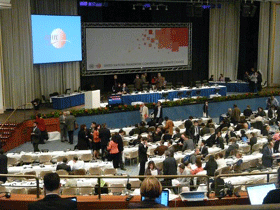
International negotiations on climate change in Bonn, Germany.
YOUNG: From the Jennifer and Ted Stanley studios in Somerville, Massachusetts, this is Living on Earth. I’m Jeff Young.
CURWOOD: And I’m Steve Curwood.
In December the nations of the world are planning to gather in Copenhagen to come to a new agreement to fight climate change. The Kyoto Protocol expires in 2012. In the beginning of June, delegates came to Bonn, Germany for a two-week meeting intended to hammer out some details of a new deal. And Living on Earth’s Bruce Gellerman joins me now from Bonn. Hi there Bruce.
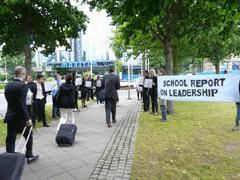
UNFCCC Delegates are welcomed by demonstrators in Bonn, Germany. (Photo: Bruce Gellerman)
CURWOOD: So Bruce, this meeting is now the second in a series of five leading up to Copenhagen in December--- and I think the UN set up so many meetings because they easily get bogged down and need a lot of time. What kind of progress was there this time?
GELLERMAN: Well, for the first time there is a working draft of the text of a proposed climate treaty, and that’s a big deal. And delegates have been scrutinizing every word and every punctuation mark. But the problems at this stage aren't with the details. I spoke with Jennifer Morgan - she's director for the global climate change program at the European environmental think-tank called E3G.
MORGAN: I think there was progress just in moving forward on getting that text ready and discussing and understanding country positions but as far as making progress to really solving the problem and seeing signals from the big polluting countries that they're going to do something significant, no.
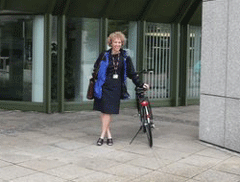
Jennifer Morgan, director of global climate change for E3G, in front of the UN Environment Building in Bonn. (Photo: Bruce Gellerman)
GELLERMAN: Well, there are two major issues - A - the big industrial countries - the ones in the Northern Hemisphere that Jennifer Morgan calls the big polluters - the question for them is: how much are they willing to cut greenhouse gas emissions, and B - money and technology - how much support will these big nations provide, you know, the developing countries.. To help them confront and adapt to climate change...change, which they say industrial nations caused.
CURWOOD: So, how now does the U.S. fit into this?
GELLERMAN: Well, under the Waxman Markey Bill, which is making its way through Congress, the United States would make domestic emissions reductions about 4 percent below 1990 levels – now you might recall Steve the Kyoto Protocol, which the United States signed that way back when, but never ratified the calls for cuts to seven percent below 1990, so the United States has slid backwards in the eyes of some.
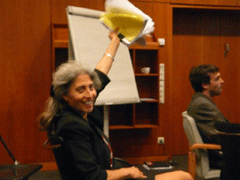
Annie Petsonk from the Environmental Defense Fund waves a copy of the Waxman-Markey climate change bill at the meetings in Bonn.
ESSOP: What did not help of course was Japan's announcement in the plenary about their targets. This was a real trust killer. Japan chose to make the announcement in the plenary in front of vulnerable countries, and clearly the kind of targets they placed on the table takes us on an emission a pathway up to three degrees or beyond.
CURWOOD: So, she’s talking about three degrees of global warming. Scientists say we’re gonna be in deep trouble if we have more than two degrees.
GELLERMAN: Yes, floods and climate change could be cataclysmic. But you know it’s still early on and Yvo de Boer, who’s the Executive Secretary of the UN Climate Organization, says he is not about to give up.
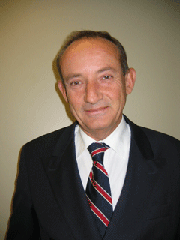
Yvo de Boer is the the Executive Secretary of the UNFCCC. (Courtesy the United Nations)
CURWOOD: And how much money on the table are they talking about, I mean how ambitious, is ambitious?
GELLERMAN: Sit down Steve! 250 billion dollars a year to help poor nations - that does include direct aid and the transfer of high tech technology.
CURWOOD: They're going to need a very big table!
GELLERMAN: Yeah, and there are a number of formulas and ways the negotiators are going to come up with it – here’s Yvo De Boer again.
DE BOER: At the end of the day, it always comes out of the taxpayer’s pocket. I hope that we will find a formula that basically follows the polluter-pays principle, and as far as I’m concerned, you can eat strawberries in the dead of winter, providing that you pay the environmental cost associated with getting those strawberries to you at that unsustainable moment in time.

A sign posted near the UNFCCC meeting. (Photo: Bruce Gellerman)
GELLERMAN: Exactly, that’s the idea - and while the United States is the richest nation, China recently surpassed us as the number one polluter of greenhouse gases - which was why all the negotiators here in Bonn were talking about the bi-lateral negotiations going on between the United States and China in Beijing.
I spoke with Jonathan Pershing; he’s the deputy special envoy for climate change in the State Dept. He just flew into Bonn right from Beijing.
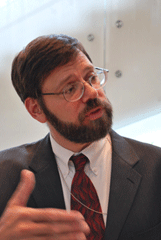
Jonathan Pershing.
CURWOOD: Bruce, before you go, tell about the speculation around President Obama coming to Copenhagen.
GELLERMAN: Yes, there was a lot of talk about that - which is why I asked Yvo de Boer, the executive Secretary of the UN Framework on Climate Change, if he thought President Obama would show up in Copenhagen in December for the final negotiations.
DE BOER: I think it would help a lot because Mr. Obama would come to celebrate success, so his arrival would be the signal of that.
GELLERMAN: Do you expect to see him there?
DE BOER: I don’t know.
GELLERMAN: I guess the question is “Do you expect to be successful?”
DE BOER: Um, I expect to be successful. I think we have to be successful. I think that Copenhagen is a unique moment in time that the world is looking for an answer there. What we’re still lacking is the Paul Revere who can ride out and get us the answer in Copenhagen. That’s why I’m calling for political leadership, but I think it will be done.
GELLERMAN: I can just see it - President Obama riding a horse through the streets of Copenhagen yelling, “Climate change is coming - climate change is coming!”
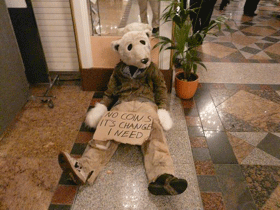
A protester asks for change. (Photo: Bruce Gellerman)
GELLERMAN: There are three more rounds of UN talks - this summer and fall: Bonn, Bangkok and Barcelona. But the real action will be in Italy next month when the world’s wealthiest nations meet, and then in September when heads of state meet at the UN in New York - and then there's another big meeting in Pittsburg – and then on to Copenhagen in December.
CURWOOD: Thanks Bruce.
GELLERMAN: My pleasure Steve.
CURWOOD: Living on Earth's Bruce Gellerman at the UN Climate negotiations in Bonn, Germany.
Related links:
- Read the UNFCCC draft negotiating text.
- To see the website of the Bonn Negotiations, click here.
- To see videos of statements from governments, UN officials and non-governmental organization at the Bonn meet, click here.
- To see a video of the closing press statement from Jonathan Pershing, Deputy Special Envoy on Climate for the United States, click here.
Climate Change and America’s Poor
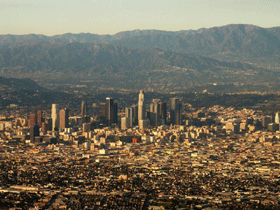
In Los Angeles, blacks are twice as likely to die during a heat wave than other city residents. (Photo: Storm Crypt )
YOUNG: The effects of climate change would likely hit hardest in places with the fewest resources to adapt. And we're not just talking about the developing world or tiny island nations.
University of California-Berkeley environmental health scientist Rachel Morello-Frosch studied low-income communities in the U.S. and found something she calls a climate gap.
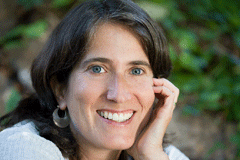
Report co-author Rachel Morello-Frosch.
YOUNG: Let’s take a closer look at a couple of these. The most obvious, I guess, is the warming part of global warming. And you studied heat waves. And I found this pretty striking, that in Los Angeles, a black Angelino is twice as likely to die during a heat wave compared to the rest of the city. Why is that?
MORELLO-FROSCH: Well there are a lot of reasons for that. We’ve done some analysis in California that shows that communities of color and the poor live in neighborhoods that have less tree canopy which would protect them from heat and have a larger proportion of coverage of impervious surface like concrete and pavement which is gonna increase surface temperatures where they live. And they’re less likely to own things like air conditioning that can help them cool off. The other issue is that African American communities, particularly low income African American communities often have pre-existing health conditions that make them more vulnerable to heat waves such as high blood pressure, diabetes, chronic heart disease, asthma and these kinds of things. And extreme heat waves can be exacerbated.
YOUNG: Now what about the fact that these are already areas that suffer bad air. How might that change if things get warmer?
MORELLO-FROSCH: Well one of the pollutants is very sensitive to hotter temperatures is ozone, which we know can cause respiratory problems and enhanced mortality risks. And so when the weather gets hotter the pollutants that are in the air, the volatile organic compounds that come from car emissions and industrial emissions mix with other chemicals to create ozone. And when it gets hot that chemical reaction increases and the levels of ozone are expected to go up as surface temperatures increase.
YOUNG: And, again, this is something that I’m guessing is going to affect a lot of people. But what you’re finding is those most affected are again poor communities, low-income communities, communities of color.
MORELLO-FROSCH: Yes, so air quality overall is gonna be worse for everyone, but the reality is that a lot of the sources of pollution are disproportionately located in low-income communities of color. And so the levels of pollutants, the localized hot spots as we call them, are gonna be even worse in those neighborhoods that are disproportionately hosting a lot of the major pollution sources, the large industrial facilities, the refineries, the power plants, the major transportation corridors and the highways. Those communities are expected to be even more acutely affected by degrading air quality as a result of climate change.
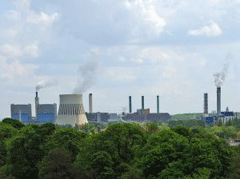
Rising temperatures are expected to make the dirty air in many low-income neighborhoods even dirtier.
MORELLO-FROSCH: Well, I think that that argument is essentially problematic. If we look at the issue of energy costs, for example, energy costs are gonna go up as a direct result of climate change itself if we do nothing and follow a business as usual scenario. Similarly climate change and water flow and droughts are gonna make it much more difficult for power plants to run efficiently. The increased costs of that energy production are inevitably going to get passed down to consumers. And those that are gonna be disproportionately impacted by those increased costs are low-income households that pay a higher proportion of their income for energy costs. So the do nothing scenario is gonna disproportionately impact the poor and is likely to be worse than any mitigation strategies that we move forward with to address climate change.
YOUNG: We can’t pretend that energy costs won’t be affected by reducing greenhouse gas emissions, can we?
MORELLO-FROSCH: Yes, either way low-income consumers are gonna pay higher energy costs. But at least when we have a policy in place and a revenue stream generated, we have the resources to cushion the blow for low-income consumers.
YOUNG: Rachel Morello-Frosch is an associate professor of environmental science at the School of Public Health at the University of California Berkeley. Thank you very much for your time.
MORELLO-FROSCH: Thank you so much.
[MUSIC] The Orb “The truth Is…..” from The Dream (Six Degrees 2009)
YOUNG: Coming up: some Californians fight climate change with forests and they're turning a profit--maybe money does grow on trees! Keep listening to Living on Earth.
Related links:
- Read “The Climate Gap” report.
- Learn more about Rachel Morello-Frosch’s policy recommendations here.
Forest Salvation
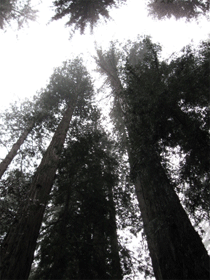
California redwoods (Photo: Ingrid Lobet)
YOUNG: It’s Living on Earth, I’m Jeff Young.
CURWOOD: And I’m Steve Curwood. We continue now with another in our ongoing series of stories about connections between changing forests and the disruption of the earth’s climate.
The burning and felling of forests is perhaps releasing one fifth of all greenhouse gases. The United Nations is trying to protect tropical forests – through REDD – the UN program on reducing emissions from deforestation and forest degradation. But the carbon balance of temperate forests also affects the climate, and that’s where California comes in. Living on Earth’s Ingrid Lobet has our story on a new exchange created to make it worthwhile for forest operators to increase carbon storage on their lands.
LOBET: On the rural highways of California's redwood country, horse trailers share the road with organic coffee delivery vans. From inside his truck, Chris Kelly points at a small grove of tall redwoods in a state park.
KELLY: This is what the whole North Coast used to look like. Big, big huge trees, widely spaced, lots of understory. But this is now increasingly rare.
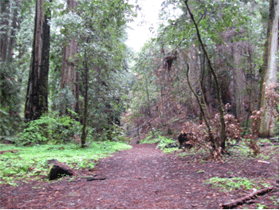
Redwoods in a California state park. Most old growth has been cut for timber over the last 60 years. (Photo: Ingrid Lobet)
KELLY: It is remarkable and this all happened really since the 70s when Robert Mondavi put California on the map. Even now it seems there is no end in developing undeveloped land into vineyards.
LOBET: That's a concern for Kelly. He's the California director for the Conservation Fund, a group that looks for intact or salvageable ecosystems to buy and protect.
The iconic large trees were the most valuable ones here. With most of them gone, owners of forestland are more likely to subdivide if they need money, selling off acres here and there.
KELLY: If there are some parcels that have coastal views, they sell those off for coastal development. For some that have potential value as vineyards, they sell those off. The result being is that over time we see the fragmentation of the landscape into myriad individual ownerships, each with their own house, each with their own septic system, each with their own domestic animals and all of a sudden the fabric of these watershed breaks down.
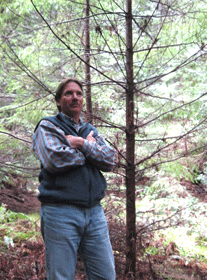
Chris Kelly, California Director of the Conservation Fund. (Photo: Ingrid Lobet)
[SOUND OF WATER RUNNING, BIRDS]
KELLY: We are standing at the top of the ridge, looking west to the Pacific Ocean. So everything you see 360 degrees from here is part of our ownership. And that sound you hear in the background is the North Fork running pretty strong, after two or three days of rain.
LOBET: It's beautiful; the air is clean. We're surrounded by trees.
KELLY: It's 24,000 acres. It comprises a third of the Garcia River watershed. It has spotted owl, it has Coho salmon, it has steelhead trout, and it has this rich mix of redwood and Douglas fir forest. So when we had the chance to buy it we jumped at the chance.
LOBET: About that same time the Conservation Fund acquired this property, California was beginning to inventory its carbon emissions in its efforts to address climate change.
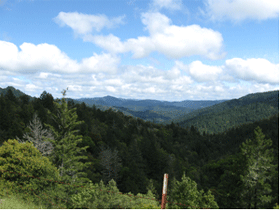
A view of the Garcia River Forest, where the Conservation Fund now owns 24,000 acres. (Photo: Ingrid Lobet)
Forest groups and forest owners pushed the legislature to create rules to legitimize this emerging market. Gary Gero is president of the non-profit California Climate Action Reserve.
GERO: The most perhaps prominent was Pacific Forest Trust in San Francisco -- The Nature Conservancy was also very active in that debate, the forest industry as well.
LOBET: California officials designated the Reserve as the arbiter of forest carbon in the state. So they convened all the interested parties to figure out what was going to qualify for forest credits.
It wasn't easy, but they quickly agreed only land that was originally forested could qualify. And only native trees would count.
And they turned to an expert who had spent years in the woods and then years on computer models for some of the technical work.
NICKERSON: My name is John Nickerson and I am a forester. My business is called Dogwood Springs Forestry.
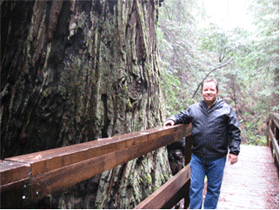
Forester John Nickerson uses computer models to predict the amount of carbon uptake in trees.
NICKERSON: So for each five-year period we have an estimate of the volume of trees, the species that will be there, the size the species and their density and from that we are able to compute carbon values. So we do the modeling approach for baseline and then for our anticipated project activities and the difference between the two is a reduction, and can be traded as an offset.
LOBET: The models Nickerson and the Climate Action Reserve use now can estimate amounts of carbon stored in a forest in five-year increments, comparing different land use scenarios.
Perhaps the stickiest question for the Reserve was how long a landowner must commit to keeping the trees standing, storing the carbon. At first the answer was… forever. Again Gary Gero.
GERO: In our first protocol we guaranteed that permanence through the conservation easements. So you were required to have a permanent conservation easement on your land to make sure the project was permanent.
LOBET: But that requirement caused the commercial timber industry to drop out of negotiations.
GERO: A lot of private landowners told us and public landowners frankly told us that that was not a mechanism they were willing to put on their land for forever.
LOBET: Recently a new version of the California forestry carbon rules was released, and the idea of permanence has now been eased.
GERO: We look at the half life of carbon in the atmosphere is about 100 years, and so we say that you need to maintain trees that are sequestering carbon, for 100 years.
LOBET: Gero says many companies still find this too strict, but this time they have signed on.
GERO: I know I met with Mendocino Redwood company recently: They told me they have been a company for ten years. It is very hard for them to imagine signing a 100-year contract.
LOBET: And any landowner who then wants to sell their land has to find a buyer willing to abide by that 100-year contract or else pay back all the credits. Finally, the Reserve also had to figure what do in the case of fire. Fire can be beneficial or catastrophic, but when there's a contract to preserve a forest for a century, fire becomes a legal risk.
GERO: All projects contribute into an insurance pool. So if there is a fire on any given project, we would take credits out of this insurance pool to ensure the ongoing permanence of those reductions.
LOBET: Once an owner has counted the trees on the ground and the computer models have output their projections, the Reserve sends an independent company out to verify data by taking tree measurements. That company also checks assumptions in the growth models. If everything checks out, the Climate Action Reserve then issues the landowner one certificate for every ton of carbon he or she has sequestered.
GERO: For instance we'll have a forest project that could be issued 100 thousand tons of credits, essentially 100 thousand tons of CO2 equivalent emissions that have been sequestered. We issue serial numbers for each and every ton, so it is akin to minting a new commodity -- this commodity is an emissions reduction that has a unique serial number. And those tons are then placed in the account of the forest owner. And they are fungible like any other commodity, that they are free to sell or to retire on behalf of the environment or hold onto in hopes of selling then in the future at a higher cost.
LOBET: The very first credits verified by the Climate Action Reserve were issued last December. And the Conservation's Fund's project on the Garcia River was one of the recipients, which says Chris Kelly, meant acting as sort of a guinea pig.
KELLY: I liken our work to get this forest verified as like driving a train on a track that is still being built. Every once in a while you get to a point where they are still laying the track and you're not sure which way to go.
LOBET: But finally the verification was over and the day came.
KELLY: So what we got was an email saying "we have just posted to your reserve account 78,000 tons of the Garcia River Forest for 2007."
LOBET: That meant the environmental group now had an account holding 78,000 Climate Reserve Tons, also known as carrots, worth about $8.00/apiece.
[BIRDS SINGING]
LOBET: Back in the Garcia River forest, Mike Stephens, a wildlife biologist, is looking for a pair of spotted owls he's been watching. He's concerned that some unusual weather may have disrupted their nesting.
STEPHENS: We are at the base of their nest tree. There is this clump of small diameter redwoods.
[BIRDS SINGING]
LOBET: As the trees in this forest mature, the hope is there will be more habitat for the endangered owls.
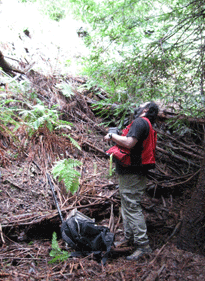
Biologist Mike Stephens searches for spotted owls by imitating their contact call. (Photo: Ingrid Lobet)
[BIRDS SINGING AND SOUND OF SMALL MAMMALS MOVING]
LOBET: Stephens has brought mice as bait and makes the sounds of prey. He waits, but no response. So he reluctantly makes a call like another owl in the territory.
[OWL CALL]
LOBET: And swiftly a large shadow passes over us and we can hear them, the pair of owls, talking to each other.
[OWLS CALLING BACK AND FORTH]
LOBET: It's a little surprising the owls chose to nest in this young tree. But the Garcia River forest doesn’t have much in the way of old growth to offer. Chris Kelly of the Conservation Fund explains that because of successive logging, this forest is what you might call a fixer upper.
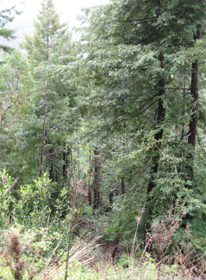
Young trees in a crowded forest.
KELLY: What we have is a thicket of young trees all struggling and competing for air and light. Whereas in a mature forest you might have 30 trees per acre, we have 300 trees per acre and so as a consequence they are all struggling to grow and none of them are growing very effectively--it's like an over-planted garden.
LOBET: To move the forest mix toward more mature trees, spaced more widely, the group has been cutting smaller trees and selling them for timber. They also need the timber money to pay for repairs after 60 years of commercials logging.
KELLY: On this 25,000-acre forest, we have 220 miles of dirt road, innumerable culverts and stream crossings, thirteen bridges. The roads need to be maintained every year to keep sediment from getting into the river; the bridges are at the end of their useful life and need to be replaced. So a fixed, irreducible cost of management. So, we thought why not have the forest help us, help it recover?
LOBET: To cut their timber they use a labor intensive, individual tree cutting process called cable-yarding.
KELLY: One end of the clothesline has a motorized pulley and then the other end of the clothesline is down in the valley or is across the valley and then you string a cable from the clothesline to the ground and then you can lift individual trees up in the air and retrieve them with the clothesline.
LOBET: This selective logging is not only making money and helping the forest mature more rapidly, the carbon-audit process for the Garcia River shows it's also increasing the rate of carbon storage.
KELLY: Ironically by us going in and selecting out some of the slower growing weaker trees and creating space for the more vigorous trees to grow, we are increasing the rate of carbon sequestration in the forest.
We have modeled the carbon accumulation in the forest over a twenty-year period. If we would just leave it alone, and we have modeled the carbon accumulation in the forest if we do the single tree selection, and we found that we get to twenty percent or more carbon sequestered in a twenty year period than had we done nothing.
LOBET: And just practically speaking the way this happens is, you remove a tree that is crowded. The sun shines down and allows more of what trees need to grow to the remaining tree, and its growth actually outperforms or outweighs what those two trees would have had if you hadn't cut the one?
KELLY: Exactly, one because now there is one tree growing with the nutrients and the space that two trees had to share and because the tree we took was the less vigorous, less productive tree.
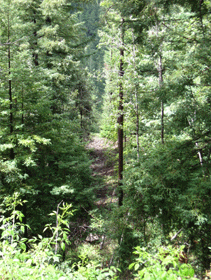
A corridor used for logging using cable yarding. (Photo: Ingrid Lobet)
KELLY: I would say that on the Garcia River forest our net annual income has doubled as a result of our ability to sell carbon offsets. If we were not enjoying the carbon revenue, then we wouldn't be able to put people to work this summer doing some of the restoration work improving the roads fixing the bridges.
LOBET: So carbon income is going to be fixing the forest this summer.
KELLY: Carbon income is going to be fixing the forest this summer. And the next and the next is my expectation.
LOBET: Kelly points out a paradox that is felt everywhere in the world where people are talking about forest carbon. The forests that are most depleted, most mistreated, sometimes have the most potential for absorbing carbon out of the atmosphere quickly.
KELLY: All of the carbon was wrung out of the forest, released into the atmosphere and in some cases into wood products, but now these young forests are like a sponge ready to soak up carbon for the next 100 years. So the forests are here to serve us in a very different way than they served us in the last century.
LOBET: He marvels that in the redwoods at least, the main income from carbon increase should come over the next 30 to 50 years, as the trees are getting big quickly. Just as that income is set to taper off, you could begin to selectively take large trees out of the forest again, and make real money from the timber.

California redwoods.
LOBET: Forest landowners aren't the only ones taking notice of this new source of income. No sooner had those carbon credits been deposited into the account of the Conservation Fund, then the phone began ringing. Wall Street investors wanted to buy them. They're betting the price will go up once the United States passes a cap on carbon emissions. Pacific Gas and Electric wants carbon credits to offer to its customers who wish to offset their personal energy emissions.
Back at the California Climate Reserve Gary Gero says these credits have already given birth to a new industry: businesses known as "forest project developers".
GERO: And what we are seeing now is that there are a number of companies out there that are specializing in investing in forest projects to obtain the carbon credits for them at a very economic return. So they invest perhaps 1 million dollars into a project, get the carbon credits at something close to four or five dollars a ton it costs them to generate those credits, knowing they can sell those credits at a higher rate later.
LOBET: The Reserve has just finished writing rules to certify credits in forests outside of California. They've been asked to verify projects in Georgia, Oregon and Pennsylvania.
Ultimately many people believe the world needs to change its fuel and energy sources to address greenhouse gas emissions. Gero and forest carbon experts say the role for trees is to tide us over until that day.
GERO: While we’re waiting for renewable energy to take hold and be the dominant energy source, forest management can start today because it doesn't require any new technology, it doesn't require anything more than a commitment to manage forests differently. And if you can manage forests better to increase sequestration in a way that is credible and permanent, you should get some credit for that and that can help bridge the gap to the new energy economy.
LOBET: In other words, the tree rush is on. For Living On Earth, I'm Ingrid Lobet, in Mendocino County, California.
CURWOOD: for more information about forests and climate change, check out our web site: loe.org.
[MUSIC] “Love Will Tear Us Apart” from Dept Of Good And Evil (Savoy Jazz 2007)
YOUNG: Just ahead the little sub that could. Stay with us - on Living on Earth.
Related links:
- California's Forest Carbon Authority
- The Conservation Fund
Tiny Glider Swims Big

RU-27 starts its underwater journey. (Photo: Rutgers University)
CURWOOD: It’s Living on Earth. I’m Steve Curwood.
YOUNG: And I’m Jeff Young.
A team of students and professors from Rutgers University recently launched a project they hope will make seagoing history by remote control. They're sending a little underwater robot across the Atlantic from New Jersey to Spain to learn more about changes affecting our seas. IEEE Spectrum’s Ari Daniel Shapiro was there.
[BIRD SOUNDS]
SHAPIRO: At six in the morning just as dawn was breaking, Scott Glenn, an oceanographer at Rutgers University, was bristling with excitement.
GLENN: Yes, this is a big day. The launch of one of these long duration missions is something you work for for months. And when it’s finally there, it starts a whole new phase of the project. And so, it’s about to start a great day.
[SOFT CHATTER]
SHAPIRO: Glenn’s talking about the launch of the glider RU27. This underwater robot looks like a mini yellow submarine and it’s about six and a half feet long. It can stay at sea for months because it has no people onboard. It’s piloted remotely from a lab at Rutgers, on shore. RU27 zigzags slowly up and down underwater, taking the temperature of the ocean and measuring how salty it is, among other things. Every time the glider surfaces, it uses a global cell phone to call the lab – literally – to send in the data it’s collected and receive instructions on where to go next. The information it’s collecting might tell us something about the impact of climate change on the ocean.
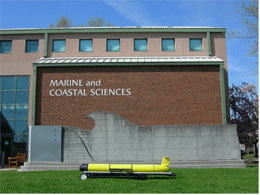
RU-27, developed by researchers at Rutgers University, is an underwater robot that collects oceanic data. (Photo: Rutgers University).
SHAPIRO: Later that morning, Glenn and part of the glider team were on a boat headed off the coast of New Jersey to do the launch.
GLENN: Gliders are changing the way we go to sea. I used to come out of this field station and we’d spend the whole day and we’d do maybe five stations. It would take us all day to do that. We’d come back exhausted. Now we send out a robot to do the same thing. And instead of going out for one day, it’s gonna go out for nine months.
SHAPIRO: If successful, RU27 will be the first remote controlled object to cross an ocean underwater. The route: New Jersey to Spain. A team of Rutgers undergrads will be the ones piloting RU27 from the lab on shore; using everything they’ve learned about currents and the oceans to make the mission a success.
[LAB SOUNDS]
SHAPIRO: Back in the lab, sophomore and RU27 co-pilot Emily Ragowski says she’s excited about the launch.
RAGOWSKI: It’s a big day but honestly, it like – it’s time. RU27 needs to get out there. We’ve been working on her for sooo long. I feel like it’s time for her to start this mission.
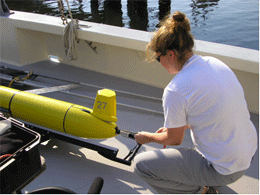
Tina Haskin, a technician in the Coastal Ocean Observation Laboratory at Rutgers' Institute of Marine and Coastal Sciences, works with the RU-27 on the day of its launch. (Photo: Rutgers University).
[SPEAKER PHONE DRONE]
SHAPIRO: When the speakerphone announced the glider had been lowered into the Atlantic, the lab honored the moment.
SPEAKER PHONE: Alright, she’s free. She’s off.
[APPLAUSE]
SHAPIRO: The same jubilation erupted aboard the boat.
GLENN AND OTHERS: Good job, good job, good job. You guys build good gliders!

RU-27 starts its underwater journey. (Photo: Rutgers University)
HASKINS: Yeah, the first test – she just didn’t dive fast enough. We should’ve seen her kind of start to descend a little more quickly than what we did.
[LAB SOUNDS]
SHAPIRO: Haskins wondered whether there was a weight missing in RU27. She phoned the lab to ask if they had found anything suspiciously heavy lying around.
LAB: I don’t see anything there. The room’s nice and clean.
[BOAT SOUNDS]
SHAPIRO: In the end, the team figured out there was actually a typo in the mission they programmed. Scott Glenn says RU27 was just following orders.
GLENN: It’s nice that it does exactly what it’s told, even if it’s wrong. It’s probably fine. We’ll find that out soon.
[LAB SOUNDS]
SHAPIRO: And RU27 was fine. The boat team finished their tests, made some last minute adjustments, and transferred control of the glider to shore. Back at the lab, the team waited for the glider to surface and make its first data phone call.
LAB: Oh, there it is! Ahh!
[BOAT SOUNDS]
SHAPIRO: As the folks in the lab finished their tests, they got ready to send the glider underwater to begin its mission. Those on the boat looked at RU27 bobbing at the surface one last time.
HASKINS: Alright, bid farewell! She’s going. This is the last time we’ll see her on the surface for a while!
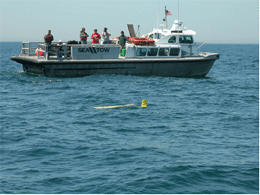
Researchers glimpse RU-27 before the glider plunges underwater. (Photo: Rutgers University)
SHAPIRO: Scott Glenn’s excitement endured, even through this exhausting day. The kids go out on their own – they’re ready to go, they’re ready to fly.
[LAB SOUNDS]
SHAPIRO: The seven-month journey is not without danger. Severe weather like hurricanes could damage RU27 or blow it way off course. Sharks might attack it. And it’s got limited battery power to make the voyage. Oscar Schofield’s an oceanographer at Rutgers.
SCHOFIELD: And now, what we’ll do, is when it starts its standard mission, it calls in every six hours. And pretty much everyone’s gonna be hanging on a phone call every six hours for the next seven months. But that’s calmer than it’s been the last few months.
SHAPIRO: I’m not sure it’s gonna be that much calmer. In RU27’s first week at sea, the team had to maneuver around a maze of fishing nets and deal with a sensor malfunction. And that was just the first 100 miles, of 3000.
For Living on Earth, I’m Ari Daniel Shapiro.
YOUNG: And that story comes to us courtesy of Spectrum Radio, the broadcast edition of IEEE Spectrum, the magazine of technology insiders. You can follow the sub's journey online - details at loe.org.
[MUSIC] Andrew Bird “The Trees Were Mistaken” from Soldier On (Wegawam Music 2006)
Related link:
Follow RU27's progress here.
Cool Fix for a Hot Planet
YOUNG: Just ahead – trying to tame the jungle – with a Motor City mindset. But first this Cool Fix for a Hot Planet from Lindsay Breslau.
BRESLAU: "Would you like your receipt, or shall I put it in the bag?" asks the cashier.
You consider your choices-- you could shove the flimsy paper into your already bulging wallet or ask for it "in the bag", knowing it will probably end up in the trash.
Soon you may have a third option, thanks to a company called TransactionTree.
TransactionTree's new service allows retailers to offer email receipts to their customers instead of paper ones. The service, which will be launched by several retailers in the coming months, emails a copy of the receipt to the customer and saves a copy online at NoMoPaper.com.
This environmentally friendly option could save paper, help consumers keep track of their expenses online, and shorten lines at the cash register.
So in the future, when a cashier asks you where you would like your receipt, you could say your inbox would be just fine.
That's this week's cool fix for a hot planet. I'm Lindsay Breslau.
YOUNG: And if you have a Cool Fix for a Hot Planet, we'd like to know it. If we use your idea on the air, we'll send you a sleek electric blue Living on Earth tire gauge. Keeping your tires properly inflated can save over $375 a year in fuel. That according to a study done at Carnegie Mellon University. Call our listener line at 800-218-9988, that's 800-218-99-88. Or email coolfix—that's one word, coolfix—at loe.org.
Henry Ford’s Jungle Dystopia

Author Greg Grandin explores Henry Ford’s Amazon experiment in his new book.
CURWOOD: World War II touched nearly every continent. And while few guns were fired in South America, there was fierce competition for hearts, minds and resources.
A top strategic item: rubber. The Japanese controlled the Asian sources, but as a 1944 war propaganda film declared, a key chunk of the Amazon and its rubber trees were already in the hands of America’s leading industrialist.
FILM: Among the present day pioneers of the Amazon who are lighting the way for others to follow is Henry Ford. Ford’s rubber development on the Topajoz River is an enterprise of historic proportion.
CURWOOD: Mr. Ford’s rubber development was known as Fordlandia.
Fordlandia is also the title of Greg Grandin’s book in which he explains why Ford Motors set up shop in the Amazon many years before World War Two broke out:
GRANDIN: Henry Ford by 1927 by the time he acquired a land grant from the Brazilian government, by that point he presided over the largest industrial empire in the world, he was one of the richest man in history. The only thing that was missing, the one thing he didn’t have control over was latex, was rubber.
CURWOOD: So Mr. Ford - who was famous for overcoming almost any obstacle - set about converting a piece of the rubber-rich Amazon into a source of supply and a bit of middle America.
Greg Grandin describes what an observer paddling up the river to Fordlandia would have seen.
[SPLASHING SOUNDS]
GRANDIN: The first thing you would see would be an enormous water tower with the Ford cursive logo on it. At the time in the 1920s, late 1920s, early 1930s, it was the tallest manmade building in the Amazon. You would get off the boat and to the left you would see a bunch of small workers bungalows, not unlike you would find in mill towns in the United States. Maybe half a mile in from the river you would see an industrial plant, a power house, a sawmill, a state of the art sawmill, and then a little bit further you’d find the American neighborhood, the American zone, with three or four room houses with porches. They weren’t too ostentatious, they were properly Protestant, it looked like something out of the Midwest.
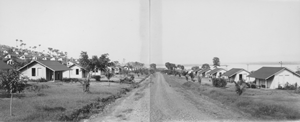
Workers’ bungalows were built after an American style.
CURWOOD: But there’s a reason this film, produced by the Disney studio for the war effort, is considered propaganda - truth was a casualty. It turns out that from the beginning, Fordlandia was someplace between a disaster and a calamity.
Again, Greg Grandin.
GRANDIN: The great thing about this story is that it brings together two extremes. Henry Ford on the one hand and the Amazon on the other—you really got an epic clash of opposites. So at one point he famously calculated that it took 7,882 distinct tasks to make a Model T. But of course the Amazon is a place where 7,882 organisms could be found on any given 5 acres. It’s the most diverse ecological system on the planet—one that moved not toward simplicity but toward the height of complexity. So you put these two things together and what you get is a story that is almost Chaplin-esque in its absurdity.
CURWOOD: Henry Ford’s managers and engineers, trained in the precision and discipline of his factory’s assembly lines, weren’t equipped to work in the sweltering rainforest. Nor did they understand the culture of the Amazon.
GRANDIN: Setting up the plantation at first and carving out the settlement out of the jungle was hard and often deadly work. Managers showed up from Dearborn, from the upper peninsula in Michigan, and they had no, they didn’t speak Portuguese, they didn’t know much about local customs or certainly local labor relations. And reports came out of the jungle that the settlement was sinking into kind of like a cesspool of waste and violence and vice. Workers fled from the construction site and they brought with them tales of knife fights of riots and strikes, of Ford managers that defrauded them of pay and also they didn’t know what they were doing in terms of how to clear jungle and turned the forest into a mudhole, burning large swaths of the jungle without the slightest idea of how to plant rubber.
CURWOOD: Still, despite the setbacks, the Ford Industrial Machine did get the settlement built – a little slice of Michigan in the jungle and the rubber began to trickle out.
But the culture clash did not disappear, and Ford’s ideas didn’t jibe with his Brazilian employees. Yes, they tolerated the rigid work schedule and they coped with their obligatory shoes. They even put up with Henry Ford’s passion for square dancing and the “Old Time Dance Orchestra” music recorded by Mr. Ford’s good friend Thomas Edison that was broadcast over loudspeakers throughout Fordlandia.
[SQUARE DANCING MUSIC]
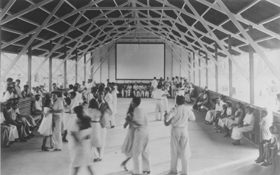
In the midst of the jazz era, Henry Ford was an ardent traditional dance hold-out. He insisted his workers enjoy this old fashioned music as well.
GRANDIN: Workers rioted. They didn’t, they weren’t interested in eating brown rice or whole wheat bread and December 22, 1930 there was an enormous riot that almost destroyed all of Fordlandia. Overturned trucks and threw equipment into the river and broke windows. The American managers had to flee into the jungle or flee by boat into the river and the Brazilian army had to come in to suppress the riot.
CURWOOD: The town was rebuilt after that – and Disney’s film celebrated Fordlandia as a marvel of modernity and the American way.
FILM: Science and skill work hand in hand to produce the finest rubber trees possible. Scientific care, the watchword of the plantation, is extended to the human element to.
Today the Ford Plantation is a successful enterprise, a tribute to skill and science. The new weapons of the 20th century pioneer.
CURWOOD: But soon after the weapons of war were laid down in 1945, Ford Motors sold Fordlandia back to the Brazilian government for pennies on the dollar. It may well be that peace – and the invention of synthetic rubber doomed Fordlandia.
But at least as responsible - if not more so - was Ford’s vision of an American utopia in the Amazon. Fordlandia is still standing today. And though Henry Ford himself never visited his unsustainable utopia - Greg Grandin has been there.
GRANDIN: It’s a small town, a little forlorn. Brazilians still live in the old worker bungalows that Ford had set up for the rubber workers. The American town is completely abandoned, given over to the jungle.
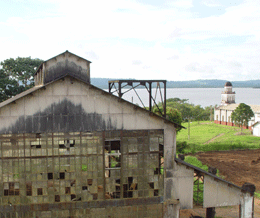
Much of Fordlandia has fallen to disrepair.
[Whistle]
Here you are in the middle of the Amazon and there’s certainly no work to go to and you hear the factory whistle blow in the morning.
[Whistle]
And it still marks time for many of the inhabitants who live in Fordlandia.
CURWOOD: So Greg, why did you write this book?
GRANDIN: I wrote the book because I think the story of Fordlandia captures something specific or particular about U.S.’s sense of itself. Ford’s obsession with raising America in the Amazon had almost nothing to do with the Amazon itself. The more Fordlandia failed on its own terms, that is, to grow rubber, the more the project was justified in idealistic terms as a civilizing mission and I think that that resonates with today.
CURWOOD: Greg Grandin’s book is called “Fordlandia: the Rise and fall of Henry Ford’s forgotten jungle city.”
[MUSIC] Bing Crosby & The Andrews Sisters “South America Take it Away” from Bing Crosby & the Andrews Sisters: Their Complete Recordings Together (MCA 1952)
Related link:
Thomas Edison recorded Henry Ford's favorite square-dance tune.
CURWOOD: On the next Living on Earth, there is a new focusing on farming on the war on drugs in Colombia.
REICHLE: Why would people leave a lucrative industry, a lucrative crop, and purely because they want to move into the legal economy. They do not want to live with violence. And coca they understand—it comes with violence.
CURWOOD: How a sustainable harvest is saving lives, and livelihoods. Next time of Living on Earth.
YOUNG: We leave you this week in the California desert.
[SOUND OF SAGE GROUSE AND COYOTE HOWLS]
YOUNG: The eerie call of the greater sage grouse and the howls of a coyote echo across the arid sagebrush of California's Great Basin. These tracks are part of the California Library of Natural Sounds collection called “Quiet Places – A Sound Walk Across Natural California.”
CURWOOD: Living on Earth is produced by the World Media Foundation. Our crew includes Bobby Bascomb, Eileen Bolinsky, Bruce Gellerman, Ingrid Lobet, Helen Palmer, Jessica Ilyse Smith, Ike Sriskandarajah, and Mitra Taj, with help from Sarah Calkins, Marilyn Govoni, and Sammy Souza.
YOUNG: Our interns are Annie Glausser, and Lisa Song. Jeff Turton is our technical director. Alison Lirish Dean composed our themes. You can find us anytime at loe.org I’m Jeff Young.
CURWOOD: And I’m Steve Curwood. Thanks for listening.
Living on Earth wants to hear from you!
Living on Earth
62 Calef Highway, Suite 212
Lee, NH 03861
Telephone: 617-287-4121
E-mail: comments@loe.org
Newsletter [Click here]
Donate to Living on Earth!
Living on Earth is an independent media program and relies entirely on contributions from listeners and institutions supporting public service. Please donate now to preserve an independent environmental voice.
NewsletterLiving on Earth offers a weekly delivery of the show's rundown to your mailbox. Sign up for our newsletter today!
 Sailors For The Sea: Be the change you want to sea.
Sailors For The Sea: Be the change you want to sea.
 The Grantham Foundation for the Protection of the Environment: Committed to protecting and improving the health of the global environment.
The Grantham Foundation for the Protection of the Environment: Committed to protecting and improving the health of the global environment.
 Contribute to Living on Earth and receive, as our gift to you, an archival print of one of Mark Seth Lender's extraordinary wildlife photographs. Follow the link to see Mark's current collection of photographs.
Contribute to Living on Earth and receive, as our gift to you, an archival print of one of Mark Seth Lender's extraordinary wildlife photographs. Follow the link to see Mark's current collection of photographs.
 Buy a signed copy of Mark Seth Lender's book Smeagull the Seagull & support Living on Earth
Buy a signed copy of Mark Seth Lender's book Smeagull the Seagull & support Living on Earth

